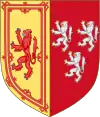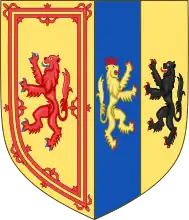List of Scottish royal consorts
The consorts of the monarchs of Scotland, such as queens consort, princesses consort, and kings consort, bore titles derived from their marriage. The Kingdom of Scotland was first unified as a state by Kenneth I of Scotland in 843, and ceased to exist as an independent kingdom after the Act of Union 1707 when it was merged with the Kingdom of England to become the Kingdom of Great Britain.
The early history of Scotland is confused and often obscure, due largely to information given by the sources of the time and after, which are often contradictory, vague, and lacking in detail. Details of the kings prior to Malcolm III are sparse, and the status of two – Giric and Eochaid – dubious; details of their wives are almost non-existent. Thus, it is practically impossible to construct a list of consorts of Scotland prior to the accession of Macbeth, whose wife Gruoch is well-documented and somewhat notorious.
House of Moray
Although a few details of earlier queens consort are known – for example, Duncan I was married to a woman named in one source as Suthen – the first queen about whom much is known is Gruoch, a daughter of Boite mac Cináeda, himself a son of either Kenneth II or Kenneth III. She was the wife of Macbeth and her son was Lulach. The mother of Máel Snechtai, Lulach's son, was still alive in 1078, when she was seized by Malcolm Canmore, but nothing else is known of her, not even if she and Lulach were married.
| Picture | Name | Father (House) | Birth | Marriage | Became consort | Coronation | Ceased to be consort | Death | Spouse |
|---|---|---|---|---|---|---|---|---|---|
| Gruoch of Scotland | Boite mac Cináeda (MacAlpin) |
c. 1015 | after 1032 | c. 14 August 1040 | – | 15 August 1057 | c. 1060 | Macbeth |
House of Dunkeld (1058–1286)
In 1058, Malcolm Long-neck of the House of Dunkeld overthrew his cousin, Lulach, and reclaimed the Scottish throne for himself. His family, the House of Dunkeld, would rule until the death of Alexander III in 1286, with whom the House ended. Alexander's heir was his infant granddaughter, Margaret, "the Maid of Norway", of the House of Fairhair; but she died, still unmarried and childless, in late 1290 before reaching Scotland, and was never crowned at Scone. After two years of Interregnum, the controversial John de Balliol was chosen as king (his wife was already dead, and never became queen consort); but after four years of reign, he abdicated, and Scotland entered another Interregnum until 1306.
| Picture | Name | Father (House) | Birth | Marriage | Became Consort | Coronation | Ceased to be Consort | Death | Spouse |
|---|---|---|---|---|---|---|---|---|---|
| Ingibiorg Finnsdottir | Finn Arnesson | ? | ? | 1058? | – | 1058/69? | Malcolm III | ||
 |
Margaret of Wessex | Edward the Exile (Wessex) |
c. 1045 | 1070 | – | 13 November 1093 | 16 November 1093 | ||
| Ethelreda of Northumbria | Gospatric, Earl of Northumbria | ? | 1093/94 | – | 1094 | ? | Duncan II | ||
| Sybilla of Normandy | Henry I of England (Normandy) |
1092 | 1107 | – | 12/13 July 1122 | Alexander I | |||
| Maud of Northumbria | Waltheof II, Earl of Northumbria | 1074 | 1113 | April/May 1124 | – | 1130 | David I | ||
| Ermengarde de Beaumont | Richard I, Viscount de Beaumont (House of Beaumont) |
c. 1170 | 5 September 1186 | – | 4 December 1214 | 12 February 1233/34 | William I | ||
 |
Joan of England | John of England (Plantagenet) |
22 July 1210 | 21 June 1221 | – | 4 March 1238 | Alexander II | ||
 |
Marie de Coucy | Enguerrand III, Lord of Coucy (Coucy) |
c. 1218 | 15 May 1239 | – | 6 July 1249 | 1285 | ||
 |
Margaret of England | Henry III of England (Plantagenet) |
29 September 1240 | 26 December 1251 | 26 February 1275 | Alexander III | |||
 |
Yolande de Dreux | Robert IV, Count of Dreux (Dreux) |
c. 1265 | 15 October 1285 | 19 March 1286 | 2 August 1322 | |||
House of Bruce (1306–1371) (Bruis)
In 1306, Robert the Bruce and his wife, Elizabeth de Burgh, were crowned King and Queen of Scots at Scone, ending the Scottish interregnum. The Bruce family would rule until the death of David II in 1371.
| Picture | Name | Father (House) | Birth | Marriage | Became consort | Coronation | Ceased to be consort | Death | Spouse |
|---|---|---|---|---|---|---|---|---|---|
 |
Elizabeth de Burgh | Richard Óg de Burgh, 2nd Earl of Ulster (de Burgh) |
c. 1289 | 1302 | 25 March 1306 | 27 March 1306 | 27 October 1327 | Robert I | |
 |
Joan of England | Edward II of England (Plantagenet) |
5 July 1321 | 17 July 1328 | 7 June 1329 | November 1331 | 7 September 1362 | David II | |
 |
Margaret Drummond | Sir Malcolm Drummond (Drummond) |
c. 1340 | 20 February 1364 | 20 March 1369 Divorced by husband |
31 January 1375 | |||
House of Stewart (1371–1707) (Gælic: Stiubhart)
Direct line (1371–1542)
Upon the death of David II in 1371, his nephew, Robert Stewart (the son of Walter Stewart and Marjorie Bruce, herself the daughter of Robert I by his first marriage) acceded to the throne. His direct line of heirs would continue to rule until the death of his last direct male descendant, James V. James left only a six-day-old girl as his heir, prompting his angry exclamation, "The devil go with it! [The rule of the Stewarts] will end as it began. It came with a lass, and it will pass with a lass." In this he was wrong: Mary would marry a member of a junior branch of the Stewart family, and the line they founded would rule not only Scotland but also England and Ireland until 1714. However, the final Stewart monarch was a woman, Anne, Queen of Great Britain.
| Picture | Arms | Name | Father (House) | Birth | Marriage | Became consort | Coronation | Ceased to be consort | Death | Spouse |
|---|---|---|---|---|---|---|---|---|---|---|
 |
 |
Euphemia de Ross | Aodh, Earl of Ross (Ross) |
before 1333 | 2 May 1355 | 22 February 1371 | 1386 | Robert II | ||
 |
 |
Anabella Drummond | John Drummond, 11th Thane of Lennox (Drummond) |
c. 1350 | 1367 | 19 April 1390 | August 1390 | 1401 | Robert III | |
 |
 |
Joan Beaufort | John Beaufort, 1st Earl of Somerset (Beaufort) |
c. 1404 | 2 February 1424 | 21 May 1424 | 21 February 1437 | 15 July 1445 | James I | |
 |
 |
Mary of Guelders | Arnold, Duke of Guelders (Egmond) |
c. 1434 | 3 July 1449 | 3 August 1460 | 1 December 1463 | James II | ||
_by_Hugo_van_der_Goes.jpg.webp) |
 |
Margaret of Denmark | Christian I of Denmark (Oldenburg) |
23 June 1456 | July 1469 | before 14 July 1486 | James III | |||
 |
 |
Margaret of England | Henry VII of England (Tudor) |
28 November 1489 | 25 January 1502 (by proxy) 8 August 1503 |
8 August 1503 | 9 September 1513 | 18 October 1541 | James IV | |
 |
 |
Madeleine of Valois | Francis I of France (Valois) |
10 August 1520 | 1 January 1537 | 7 July 1537 | James V | |||
 |
 |
Mary of Guise | Claude, Duke of Guise (Guise) |
22 November 1515 | 18 May 1538 | 22 February 1540 | 14 December 1542 | 11 June 1560 | ||
House of Stuart (1542–1649)
In 1542, James V died, leaving his daughter Mary as Queen of Scots. Mary was later sent by her mother to the French court, where her surname was gallicised to Stuart. Mary married Henry Stuart, Lord Darnley, a member of a junior branch of the Stewart family (who had also gallicised their surname to Stuart). Their son, James VI, established the Stuart dynasty, which would rule not only Scotland but also England and Ireland. Their rule was briefly terminated with the Civil War, in which Charles I was executed and the Commonwealth declared; between 1649 and 1660, England, Scotland and Ireland were ruled by Parliament, dominated by Oliver Cromwell.
| Picture | Arms | Name | Father (House) | Birth | Marriage | Became consort | Coronation | Ceased to be consort | Death | Spouse |
|---|---|---|---|---|---|---|---|---|---|---|
 |
.svg.png.webp) |
Francis II of France | Henry II of France (Valois) |
19 January 1544 | 24 April 1558 | 5 December 1560 | Mary I | |||
 |
 |
Henry Stuart | Matthew Stewart, 4th Earl of Lennox (Stuart) |
7 December 1545 | 29 July 1565 | 9/10 February 1567 | ||||
 |
 |
James Hepburn, 4th Earl of Bothwell | Patrick Hepburn, 3rd Earl of Bothwell (Hepburn) |
c. 1534 | 15 May 1567 | 24 July 1567 Wife's abdication |
14 April 1578 | |||
 |
 |
Anne of Denmark | Frederick II of Denmark (Oldenburg) |
12 December 1574 | 23 November 1589 | 17 May 1590 | 2 March 1619 | James VI | ||
 |
 |
Henrietta Maria of France | Henry IV of France (Bourbon) |
25 November 1609 | 13 June 1625 | 30 January 1649 husband's execution |
10 September 1669 | Charles I | ||
House of Stuart (restored) (1660–1707)
In 1660, Charles II, son of the executed Charles I, was restored to the thrones of England, Scotland and Ireland, and Stuart rule began again. James VII, his brother, was overthrown in 1688–89 because of his Catholic faith; his daughters, Mary II and Anne, were the last Stuarts to rule in the British Isles, Anne dying in 1714. The Kingdom of Scotland, however, had already ceased to exist in 1707, when the Act of Union amalgamated the Kingdoms of England and Scotland into a united Kingdom of Great Britain. James VII's son, James Francis Edward Stuart, refusing to accept the Act of Union, claimed the English and Scottish thrones, as did his son Charles Edward Stuart; however, they are not considered legitimate Kings of Scotland, since they never effectively secured their claims, and so their wives are not listed here.
| Picture | Name | Father (House) | Birth | Marriage | Became Consort | Coronation | Ceased to be Consort | Death | Spouse |
|---|---|---|---|---|---|---|---|---|---|
 |
Catherine of Braganza | John IV of Portugal (Braganza) |
25 November 1638 | 21 May 1662 | 6 February 1685 | 31 December 1705 | Charles II | ||
 |
Mary of Modena | Alfonso IV d'Este, Duke of Modena (Este) |
5 October 1658 | 30 September 1673 | 6 February 1685 | 23 April 1685 | 11 December 1688 | 7 May 1718 | James VII |
 |
George of Denmark | Frederick III of Denmark (Oldenburg) |
2 April 1653 | 28 July 1683 | 8 March 1702 | 1 May 1707 Kingdoms of Scotland and England amalgamated; Anne becomes Queen regnant of the Kingdom of Great Britain, George royal consort of the same |
28 October 1708 | Anne | |
- For the subsequent consorts of Great Britain and the United Kingdom, see List of British consorts.